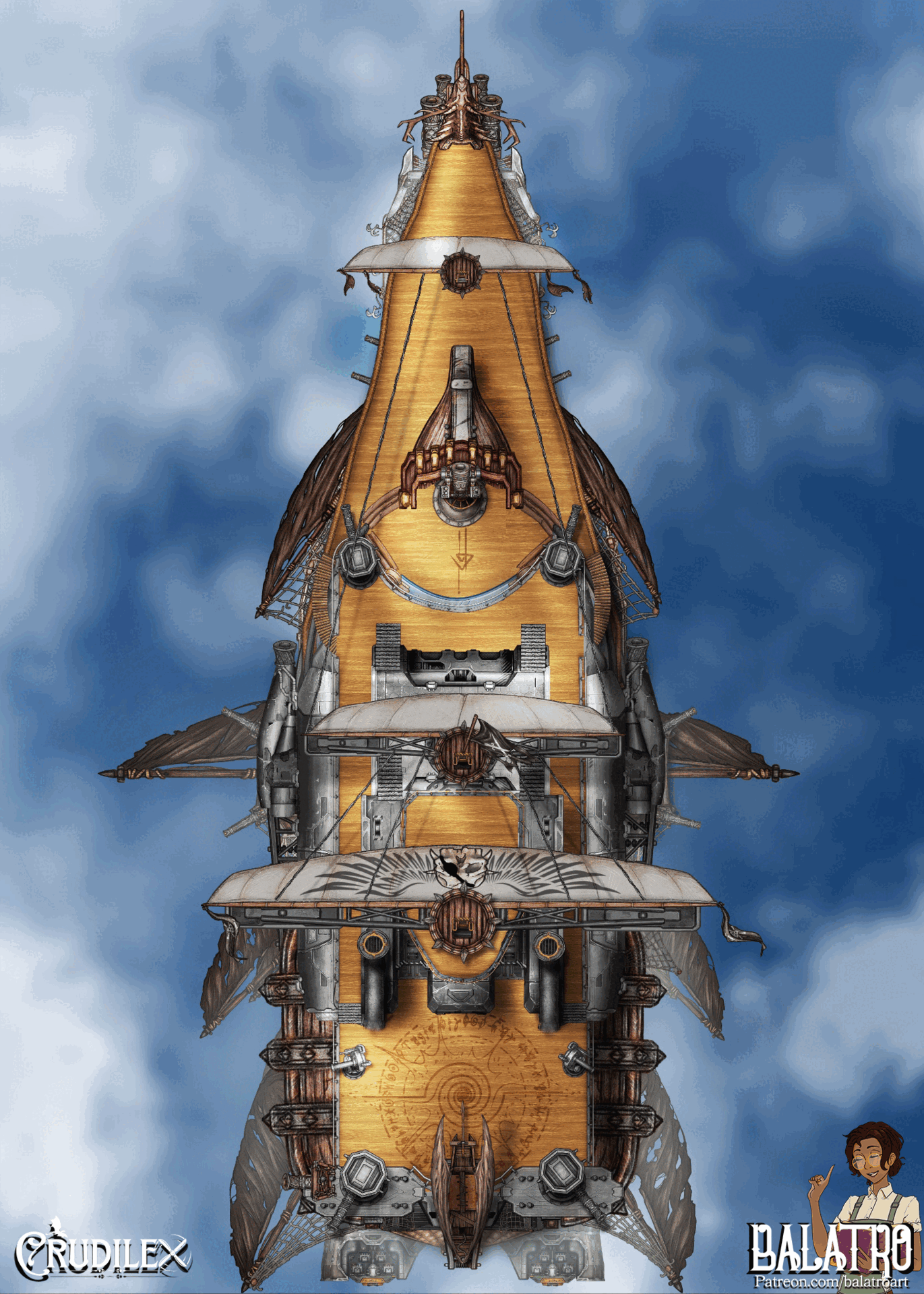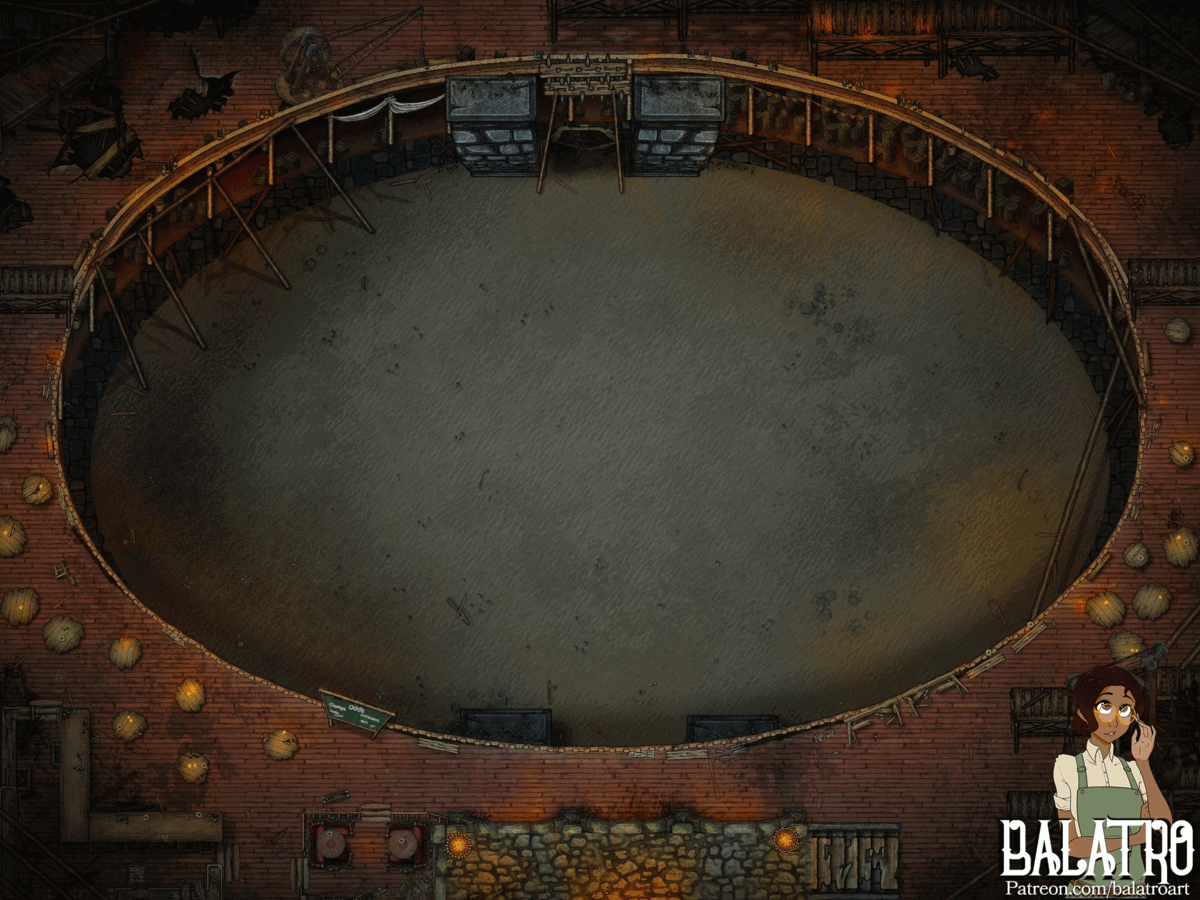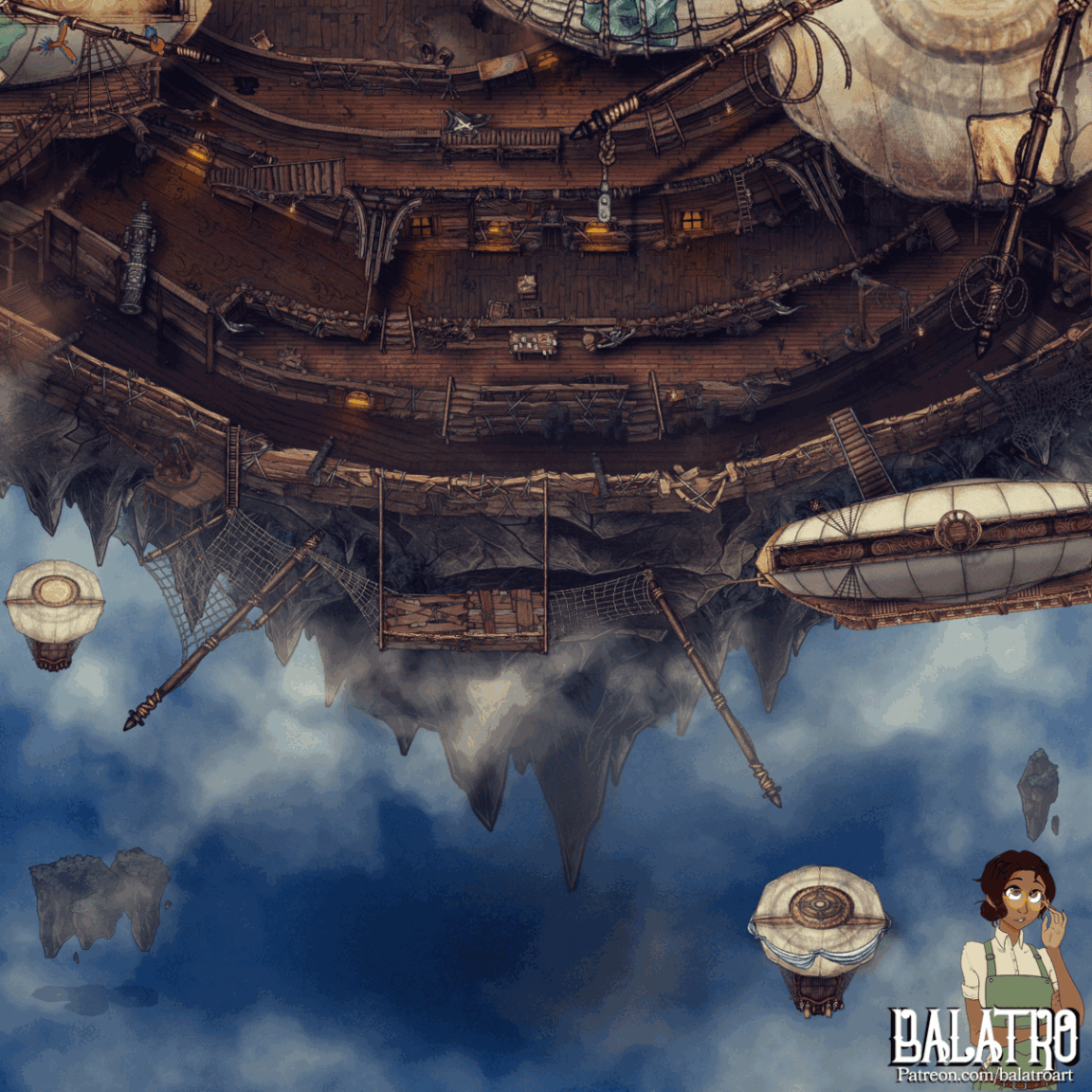
La Gaviota
The floating island of La Gaviota is considered sacred ground by the superstitious airship pirates of Crudilex. Protected by both enemies and allies, all conflicts between brigadiers are left far beyond its borders. The living embodiment of this truce is venerated by the coven matron, Mama Kass, who resides in a great tree at the center of the floating isle. The island drifts slowly along the Nostradan-Colloran Empire border, preying upon trade ships and caravans that cross between. Despite the grim and often serious nature of their business, the pirates of La Gaviota live lives of levity and splendor. The streets are filled with music, and the taverns overflow with drink. Gambling, partying, and revelry are daily pastimes for its citizens. Thanks to the extremely strict ban on black powder, thosand, and firearms, the streets remain largely free of the violence common among swashbucklers. The true splendor of La Gaviota lies in its central position to airship travel across Crudilex. It is the absolute best place to gather information and learn the legends of the sky.
Battlemaps set in this location
Iari Blimps
A series of gigantic circular balloons, held to the island with a tangle of rigging and rope, lift and steer La Gaviota on its journeys around the world.
One of the unlocked properties discovered in iari crystal is something called "Cymatic Magnetism," where each crystal locks in a suspended gravity in tandem with others, forming patterns in the air that shift and move as a unit. In contrast to its usual locked behavior, iari clusters exhibit upward or forward lift, making them the perfect medium for building airships.
Sturdy canvas and anchors are constructed around these iari grid patterns, and the crystals are coaxed into specific arrangements to direct movement. The technology has no upper limit on size, limited only by the supply of refined iari crystals shaped to fit their proper pattern. Though undoubtedly the slowest means of airship travel, it requires no fuel whatsoever, giving anyone with access to iari the same opportunities the sky affords.
The Haggard Hand
This beautiful, white-gilded old-elven airship has a name that couldn’t be more misleading. It is a magnificent vessel, almost too fine to fly among the pirates of La Gaviota, and would be more at home in a grand Nostradanian sky yacht show or on a showroom floor.
The crew is equally dignified, clean, and uniformed, each sailor prim and well-behaved. Nothing about this ship says "pirate," except for its infamous legend and fearsome reputation.
The Atarax
Blimp airships are a favorite of merchants and trade groups for their ability to carry heavy loads and their total independence from fuel. Held aloft by iari patterns, they can float anywhere in the world, albeit quite slowly.
Because of this sluggish pace, airship pirates usually ignore them as viable vessels for crew use. Fast strikes and quick getaways are the norm, success comes from making off with the booty before reinforcements arrive. The Atarax turns this model on its head.
This pirate blimp focuses its raids on settlements, using intimidation and reputation to do most of the work without firing a single shot. It hovers in the clouds above a town, threatening destruction, and sends a single
skirmisher mono-skiff to negotiate. Once terms are agreed upon, the Atarax lands and loads up like any merchant blimp before vanishing back into the clouds.
It’s one of the most successful and profitable crews on the island. Merchants love them—they leave no bodies, no destruction, and insurance often covers the loss. Some say the crew was originally a transport ship that realized "stealing" this way was far easier.
Hush-House
Perched on a terrace at the island’s edge, past a series of old ladders bolted into the rock and a rope-bridged gap, stands the Hush-House. One of the island’s earliest buildings, it was assembled by the first occupants, the Hags of Swals.
Little is known of this first coven, but out of reverence, the Hush-House is left untouched. It resembles a haunted church with a high pointed roof in the Lucan style. Its massive front doors, pitch-black and bound with chains, remain locked.
At night, locals claim a voice can be heard behind them, offering candy to children in exchange for stories from the island.
Bruno's Brothel
One of three brothels owned by the tiefling businessman Bruno, this airship features red and gold motifs, extravagant designs, and a hull more like a flying building than a vessel. Bruno rarely visits, having little fondness for pirates, though he’s more than happy to take their money. The brothel is a well-known destination in La Gaviota.
Slickstone Alley
This wet cobblestone alley serves as a shortcut through the city but is notorious for ambushes. It also contains one of the few known passageways down to Underside-the darker, less festive part of La Gaviota.
The city’s streets weren’t planned. Early airship pirates simply landed and dismantled their ships for lumber, building wherever they could. As storms collapse structures, stronger ones rise in their place, creating natural breezeways and alleys like Slickstone. Carved by airflow over the island’s shape, this alley is especially dangerous. Winds rush down it, and the stones stay slick with water left behind from passing clouds.
Trash Heap
The Trash Heap is a pile of anything unwanted but too valuable to discard. Locals scavenge it for ship parts and mechanical bits-engines, propellers, radios. The name is ironic, as it’s often full of useful items.
It serves as a communal engineering yard. Anyone can add or take from it. Pirate crews often take pride in tossing valuable items in, donating them to others in a symbolic gesture of support for the next generation. No one is thrilled to use parts from the Heap, but everyone is glad it exists.
Timberslag
Timberslag is a crumbling settlement spilling off the island’s edge, built from recycled wood salvaged from derelict ships and collapsed buildings. Almost nothing is wasted. Even the worst scrap can be bolted onto a walkway and given new life.
This slum is home to pirates kicked from their crews or those growing desperate between jobs. Even in poor La Gaviota, few dream of building a life in a shack dangling from the side of a floating rock.
The Geode Heart
Hidden in the stoneyard beneath Mama Kass’s tree lies a ruined crypt, overtaken by roots and crumbled marble. The tangled entrance is sealed, but Kass can manipulate the tree to reveal a secret stairwell leading deep into the mote. As one descends, the walls become pure iari-more than anywhere else in the world. The fortune of a hundred kingdoms lies beneath the pirates’ island.
The cavern opens into the sphere of a geode, dazzling with pink light and mirrored surfaces. Enormous pillars of iari, enough to lift mountains, surround a single floating figure in its center: a blooded Riven woman with long white hair, black antlers, and a crystal third eye. This is Gran, the First Hag and highest matron of Crudilex’s covens. Her presence at the island’s heart is its greatest secret. From here, she rules her covens across the world and guides the sky pirates through their superstition.
Mama Kass and the Stoneyard
Safety and legacy are the two most important things to the pirates of La Gaviota. Both of these are the sole responsibility of La Gaviota's living treaty, the coven hag Mama Kass. Kass never leaves the great tree at the center of the Stoneyard, located at the heart of the floating island—except for one purpose: burying true swashbucklers.
There is no greater honor than being interred in Mama Kass's Stoneyard. The hag touches the ground only for the duration of the death rite, and a headstone is placed above their resting place. This is considered an immense honor because very few are deemed worthy by Mama Kass to be remembered.
Pirates of La Gaviota may approach Mama Kass, leaving an offering to ask about one of the graves. If she approves of the gift, Kass will recount the swashbuckler's tale in perfect clarity. Most crews bring a portion of their haul as an offering to Kass every time they dock.
Rattlerun Airstrip
Aeroplanes were not easily adopted into the airship pirate lifestyle. But as ironclads with launch platforms and hangar bays have become more common in the skies, fast, maneuverable fighters and biplanes have become valuable tools for outmaneuvering and overwhelming enemies. And if sky pirates are using something, it has to be accounted for in La Gaviota. The eastern jetty of the mote was repurposed into a short airstrip for small planes.
Some ships now rely on this airstrip so heavily that they only raid within flying distance of it, launching their planes with catapults but having no way to recover them at sea. After combat, the planes return to land here.
Rattlerun earned its name from the failing quality of the biplanes often seen departing from it, barely held together by rivets and dreams. The pirates of La Gaviota are used to ad-hoc engineering with little to work with. Faith in the machine is hard-won, but the pilots swear by their puttering, airborne trash heaps.
The Flotilla Market
Surrounding La Gaviota like a swarm of satellite moons is a network of airships, rope bridges, and gangplanks. Together, they form an amoebic, ever-changing marketplace that sprawls across the top decks of moored ships, creating a massive, floating courtyard. Hundreds of airships come here to trade and deal. It’s the one market where a merchant can be absolutely sure no sky pirate will attack them, because it’s the pirates’ own market.
The one rule: no stealing, threatening, or backstabbing without permission from Mama Kass or unanimous agreement from the pirate captains. This strange arrangement allows merchants to sell freely, and pirates to offload stolen booty, often right back to the very crews they stole it from.
Skitter and Lang Airship Repair
There aren’t many places in the sky where an airship can limp in for emergency repairs without ever needing to land. Skitter and Lang is one of them. Teams of smaller skiffs fly out from the floating workshop and attach themselves directly to damaged vessels, performing mid-air patch jobs on the spot. This lets them work on multiple ships at once in the Flotilla Market, or make “house calls” to vessels in the surrounding skies via radio request.
Wilda's Place
Some taverns are rowdy. Airship pirate taverns are rowdier still. But none compare to Wilda’s Place. Barrels and crates serve as furniture, since chairs and tables are constantly being broken in fights. The drinks are few and awful. The floor is slick with spilled beer and shattered glass. The stench is indescribable. Don’t even ask about the bathrooms. And yet, somehow, every time a pirate crew moors with full pockets, this is where they go.
The crumbling shack is a local icon, a symbol of the reckless, filthy, dangerous life of an airship pirate. Wilda’s Place is universally beloved-despite being almost universally reviled.
Underside
Underside is the belly of La Gaviota. It's dark 24 hours a day, cold, and wet. Its atmosphere is the complete opposite of Upperside; the joyousness of the off-duty airship pirates is absent from the hooded, shadowed faces of the Undersiders.
Smuggling, monster trading, drug dens, and gloom reign supreme here. Anyone traveling to Underside should consider a picked pocket the least of their worries. The rotting, hanging bridges and makeshift shacks constantly threaten to send the unfamiliar plummeting down to the "Hungry Ground"—just as the Undersiders prefer.
The most notable figure in Underside is the vampire Sekal Boonwind and his thralls, who zealously rule over the shadowed streets. Pirates never seem to go missing, yet somehow, Sekal remains well-fed—a mystery the locals choose to overlook.


















